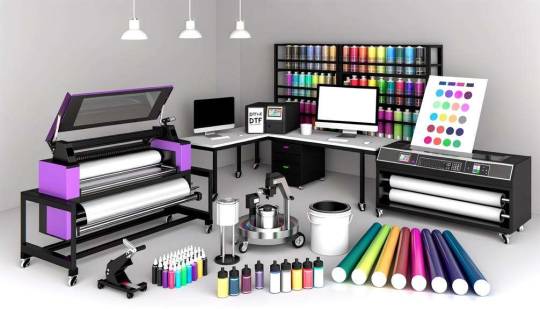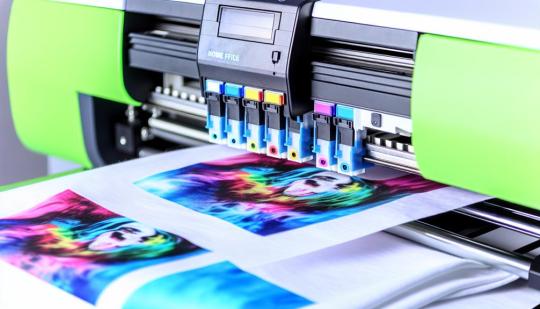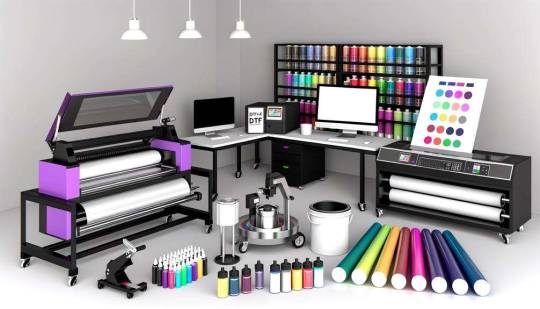Don't wanna be here? Send us removal request.
Text
DTF Transfers vs. Traditional Heat Transfer: What’s the Difference?
Introduction
In the world of custom apparel printing, several techniques have emerged to meet the ever-growing demand for high-quality designs. Among these, DTF (Direct to Film) transfers and traditional heat transfer printing stand out as popular choices. Each method has its unique advantages, limitations, and applications. Understanding these differences can significantly impact your decision-making process when selecting a suitable printing technique for your projects.
youtube

This article delves into the nuances of DTF transfers compared to traditional heat transfer methods. We will explore everything from the printing processes, materials used, equipment needed, and overall quality of prints. By the end of this comprehensive guide, you will be equipped with knowledge that empowers you to choose wisely between these two options.
What are DTF Transfers? Understanding DTF Printing
DTF printing is a relatively new technology that allows for stunningly vibrant designs on a variety of fabrics. The process involves transferring ink onto a special film using a direct to film printer, which is then adhered to the garment using heat and pressure.
Materials Used in DTF Transfers
The key components involved in DTF Transfer DTF transfers include:
Specialized Inks: Typically water-based inks that provide bright colors and excellent durability. Transfer Film: A PET film that acts as a medium for transferring designs. Adhesive Powder: This ingredient bonds the print to the fabric during the heating process. Equipment Required for DTF Printing
To successfully implement DTF printing in your workshop or business, you'll need:

A high-quality direct-to-film printer A heat press machine A computer with design software Transfer film and adhesive powder What is Traditional Heat Transfer Printing? Understanding Heat Transfer Printing
Traditional heat transfer printing involves creating designs on vinyl or paper and then applying them onto garments through heat and pressure. This method DTF Printer has been widely used for years and offers versatility in terms of design complexity.
Materials Used in Traditional Heat Transfer Printing
The fundamental materials used in traditional heat transfer printing include:
Heat Transfer Vinyl (HTV): A type of plastic material that comes in various colors. Transfer Paper: Special paper designed for inkjet or laser printers. Adhesive: Depending on whether you're using HTV or transfer paper, various adhesives may be required. Equipment Required for Traditional Heat Transfer Printing
To start with traditional heat transfer printing, you’ll typically need:
A cutting machine (for HTV) A printer (for transfer paper) A heat press or iron Design software DTF Transfers vs. Traditional Heat Transfer: What’s the Difference?
When comparing DTF transfers to traditional heat transfer methods, there are several critic
0 notes
Text
“The Role of Technology in Advancing Direct to Film Printing Methods”
Introduction: A New Era in Printing Technology
In today's fast-paced world, the printing industry is undergoing a significant transformation. One of the most revolutionary advancements is Direct to Film (DTF) printing. This innovative technology has reshaped how we think about custom apparel and graphic designs. With DTF printing, the need for traditional methods like screen printing and heat transfer is being challenged. But what exactly makes DTF so special? Let's delve deeper into the role of technology in advancing direct to film printing methods.
youtube

youtube
Understanding Direct to Film Printing What is DTF Printing? DTF Transfer
Direct to Film (DTF) printing is a cutting-edge technique that allows for high-quality prints on various materials without the need for screens or complex setups. Unlike traditional methods, DTF uses a digital printer to transfer images directly onto a film, which can then be heat-pressed onto garments. This method not only simplifies the printing process but also enhances the quality and durability of prints.
How Does DTF Transfer Work?
The DTF transfer process begins with printing an image onto a specialized film using a direct to film printer. The printed film is then coated with adhesive powder before it undergoes curing through heat. Once cured, it’s ready to be pressed onto fabric using a heat press machine. This method ensures that colors are vibrant and long-lasting, making it perfect for custom designs.
Advantages of DTF Transfers Over Traditional Methods Versatility: DTF can print on various materials. Quality: Offers high-resolution images with vibrant colors. Cost-Effective: Reduces setup costs compared to screen printing. Efficiency: Faster turnaround times for orders. Durability: Prints are resistant to fading and cracking. The Role of Technology in Advancing Direct to Film Printing Methods
As we explore the role of technology in advancing direct-to-film printing methods, it's crucial to understand how innovations have transformed this process:
Technological Innovations in DTF Printing 1. High-Quality Inkjet Printers
Modern inkjet printers designed specifically for DTF are equipped with advanced technology that allows them to produce sharp, detailed prints quickly and efficiently. These printers use eco-friendly inks that provide excellent adhesion and durability.
2. Improvements in Adhesive Powders
The development of new adhesive powders has significantly enhanced the quality of DTF transfers. These powders ensure better stickiness when applied under heat, leading to longer-lasting prints on various fabrics.
3. Software Advancements
With user-friendly design software, businesses can create intricate designs tailored to customer needs easily. This software often includes features like color management tools, allowing for precise color reproduction.
youtube
4. Automation Technologies
Automation DTF Printing has streamlined many aspects of the DTF process from printing to curing and pressing, drastically reducing labor costs while increasing efficiency.
5. UV DTF Transfers
Recent advancements have led to the creation of UV DTF transfers
0 notes
Text
“The Advantages of Using Professional DTF Printing Services”
Introduction
In today’s fast-paced world, the demand for high-quality prints is skyrocketing. Whether DTF Transfers it's for custom apparel, promotional items, or personalized gifts, businesses and individuals alike are always on the lookout for efficient printing solutions. One such solution that has gained immense popularity in recent years is Direct to Film (DTF) printing. This innovative method offers a host of benefits that traditional printing techniques simply cannot match. In this article, we will explore the various advantages of using professional DTF printing services and why they might just be the best choice for your printing needs.
What is DTF Printing?
DTF Printing stands for Direct to Film Printing, a technique where designs are printed onto a special film before being transferred onto fabrics or other surfaces using heat and pressure. This method has become increasingly popular due to its versatility and quality. Unlike traditional screen printing, DTF transfers allow for vibrant colors and intricate details to be reproduced with ease.
How Does DTF Printing Work?
The process of DTF printing involves several key steps:

Design Creation: A digital design is created or selected. Film Printing: The design is printed onto a special film using a direct-to-film printer. Powder Adhesive Application: An adhesive powder is applied to the wet ink on the film. Heat Curing: The film is passed through a heat tunnel to cure the adhesive. Transfer Process: Finally, the film with the adhered design is pressed onto the desired fabric or surface using a heat press. Why Choose DTF Over Traditional Methods?
When comparing DTF printing to methods like screen printing or heat transfer printing, it becomes clear why many are making the switch:
Faster setup times Greater color vibrancy Ability to print complex designs without additional costs The Advantages of Using Professional DTF Printing Services
So why should you consider utilizing professional DTF printing services? Here are some compelling reasons:
High-Quality Prints
One of the standout features of professional DTF prints is their exceptional quality. With advanced technology at their disposal, professional service providers can guarantee sharp details and vivid colors that stand out.
Versatility Across Materials
Professional DTF transfers can be applied to various materials including cotton, polyester, blends, leather, DTF Transfer and more. This makes them ideal for diverse applications—from clothing lines to promotional merchandise.
youtube
Durability of Transfers
Unlike some other methods where prints may fade or crack over time, professionally done DTF transfers offer resilience against wear and tear. You’ll find that these prints withstand washing and daily use remarkably well.
Cost-Effective Solutions
While there might be an initial investment in professional services, the long-term savings due to durability and reduced reprints make it cost-effective in the grand scheme of things.

youtube
0 notes
Text
Custom DTF Designs: Bringing Your Ideas to Life
Introduction
In the fast-paced world of fashion and custom merchandise, the demand for unique and personalized designs has skyrocketed. Enter Direct to Film (DTF) printing, a revolutionary method that allows businesses and individuals alike to bring their creative visions to life. With the rise of Custom DTF Designs, artists, entrepreneurs, and hobbyists can now easily create stunning prints that are vibrant, durable, and ideal for various applications. This article will explore the ins and outs of Custom DTF Designs, providing you with valuable insights into how this innovative printing technique works, its benefits, and how you can leverage it for your projects.
What is DTF Printing?
DTF Printing stands for Direct to Film printing. It involves printing designs onto a special film using high-quality inks. After printing, a powdered adhesive is applied before curing the ink with heat. The film can then be transferred to various substrates such as textiles or apparel using a heat press.
The Process of DTF Transfer Printing
The process of DTF transfer printing consists of several key DTF Transfer steps:
Design Creation: Start with a digital design, often created using graphic design software. Printing: Use a direct-to-film printer to print your design onto specialized transfer film. Adhesive Application: Apply a heat-activated adhesive powder onto the printed film. Curing: Cure the ink and adhesive using heat, ensuring they bond well. Heat Transfer: Finally, use a heat press to apply the design onto your chosen material. Benefits of Custom DTF Designs 1. Vibrant Colors and High Detail
One of the standout features of Custom DTF Designs is their ability to produce vibrant colors with exceptional detail. Because DTF uses specialized inks tailored for this process, your designs will pop on any surface.
2. Versatility in Materials
Another significant advantage is versatility; DTF transfers can be applied to various materials including cotton, polyester, canvas, and even some leather products.
3. Durability
Unlike traditional screen printing methods that can fade over time, DTF prints are designed to withstand multiple washes without losing their integrity.
4. Cost-Effective Production
For small businesses or individual creators looking for affordable options, Custom DTF Designs offer cost-effective solutions that allow for low minimum order quantities without sacrificing quality.
Exploring Direct to Film Printers
When considering starting EazyDTF DTF Printer with DTF printing or enhancing your current setup, choosing the right equipment is crucial. A good quality direct-to-film printer can significantly impact the outcome of your designs.

Best DTF Printers on the Market Epson SureColor F2100 Brother GTX Pro Mimaki UJF-3042 Roland VersaUV LEF Series
These printers are known for their reliability and quality output, making them ideal choices for businesses seeking professional results.
youtube
Who
1 note
·
View note